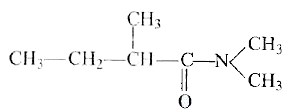CH3CH2BrAgCN−−−→ANaOH,Δ−−−−−−−−→H⊕3OB, B is :
The correct Answer is:C
To solve the given question step by step, we need to analyze the reactions involved.
Step 1: Identify the starting compound
The starting compound is CH₃CH₂Br (ethyl bromide). This is an alkyl halide.
Step 2: Reaction with AgCN
When ethyl bromide (CH₃CH₂Br) reacts with AgCN, a nucleophilic substitution reaction occurs. The cyanide ion (CN⁻) from AgCN attacks the carbon atom bonded to the bromine atom, leading to the formation of a new compound.
Reaction:
CH3CH2Br+AgCN→CH3CH2CN+AgBr
Here, the bromine atom is replaced by a cyanide group (CN), resulting in the formation of ethyl cyanide (CH₃CH₂CN), which we will denote as A.
Step 3: Hydrolysis of A
Next, we treat the compound A (ethyl cyanide) with H₃O⁺ (acidic conditions) and NaOH (basic conditions) under heat (Δ). This process is known as hydrolysis.
During hydrolysis, the cyanide group (CN) is converted into an amine group (NH₂) through the formation of an intermediate carboxylic acid (propanoic acid) before finally forming the amine.
Hydrolysis Reaction:
1. The CN group is converted to a carboxylic acid:
CH3CH2CN+2H2O→CH3CH2COOH+NH3
2. The carboxylic acid (propanoic acid) can then be converted to an amine:
CH3CH2COOH+NH3→CH3CH2NH2+H2O
Step 4: Identify the final product B
After the hydrolysis of ethyl cyanide, we obtain ethylamine (CH₃CH₂NH₂) as the final product, which we will denote as B.
Final Answer
Thus, the final product B is CH₃CH₂NH₂ (ethylamine).
---
The starting compound is CH₃CH₂Br (ethyl bromide). This is an alkyl halide.
When ethyl bromide (CH₃CH₂Br) reacts with AgCN, a nucleophilic substitution reaction occurs. The cyanide ion (CN⁻) from AgCN attacks the carbon atom bonded to the bromine atom, leading to the formation of a new compound.
CH3CH2Br+AgCN→CH3CH2CN+AgBr
Next, we treat the compound A (ethyl cyanide) with H₃O⁺ (acidic conditions) and NaOH (basic conditions) under heat (Δ). This process is known as hydrolysis.
1. The CN group is converted to a carboxylic acid:
CH3CH2CN+2H2O→CH3CH2COOH+NH3
2. The carboxylic acid (propanoic acid) can then be converted to an amine:
CH3CH2COOH+NH3→CH3CH2NH2+H2O
After the hydrolysis of ethyl cyanide, we obtain ethylamine (CH₃CH₂NH₂) as the final product, which we will denote as B.
Thus, the final product B is CH₃CH₂NH₂ (ethylamine).
Similar Questions
Knowledge Check
Ph−CH2−O∣∣C−OH(1)NaOH,CaO,Δ−−−−−−−−−−−−−−→(2)H⊕(A)
Product (A) is :APh−CO2HBPh−CH2−OHCPh−CH3D
What is compound Z ?
CH3CH2CH2BrNaCN−−−→XH3O+−−−→HeatYCH3CH2OH−−−−−−−→H+ZACH3CH=ChO∣∣COHBCH3CH2CH2CH=NOCH2CH3CCH3CH2CH2CH(OCH2CH3)2DCH3CH2CH2O∣∣COCH2CH3H3C−CH2−CH3∣CH−C∣∣O−NH2Br2+KOH−−−−−−−−−→ΔA1.CH3I(excess)−−−−−−−−−−−−→2.AgOH,ΔB
The major product (B) is :ACH3−CH2−CH=CH2B CH3C−CH=CH−CH3D
CH3C−CH=CH−CH3D
Write structures of compounds A,B and C in each of the following reactions:
(i) C6H5BrMg/dry ether−−−−−−−→A(a)CO2(g)−−−−−−−→(b)H3O+BPCl5−−→C
(ii) CH3CN(a)SnCl2/HCl−−−−−−−−−→(b)H3O+Adil.NaOH−−−−−→BΔ−−→C
View SolutionComplete the following reactions:
(i) CH3−CH3∣C∣Cl−CH2CH3alcKOH−−−−→ΔAO3−−−−−→Zn/H2O(B+C)
(ii) CH3ICH−CH3alcKCN−−−−→A(i)SnCl2/HCl−−−−−−−−−−−−→(ii)H2O.OH.H2O2B
(iii) HCNHCl/AlCl3−−−−−−→A(i)C6H6Δ−−−−−−−−−−→(ii)(H2O)/H−B
(iv)
View Solution(a) How will you convert:
(i) Aniline into Fluorobenzene.
(ii) Benzamide into Benzylamine.
(iii) Ethanamine to N,N-Diethylethanamine.
(b) Write the structures of A and B in the following:
(i) CH3CH2CNOH−−−−−−−−−−→Partial hydrolysisANaOH+Br2−−−−−−−→B
(ii) CH3CH2Br(i)KCN−−−−−−→(ii)LiAlH4ANHO2−−−→O0CB
View SolutionCH3−CH=CH2Br2−−→773K[A]KOH(alc.)−−−−−−−→Heat[B]
View SolutionCH2−CONH2|CH2−CONH2P2O5−−→Δ(P)H3O⊕−−−→Δ(Q)
The product (Q) is
View Solution
